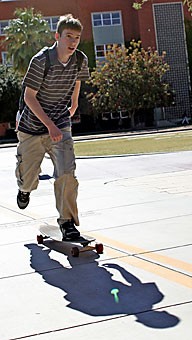Incidents of skateboard “”hot-dogging”” have gone down since the University of Arizona Police Department started vigorously enforcing university policy this year, a community service officer said.
About a year and a half ago, UAPD would only give warnings to skateboarders doing tricks, but police have started to enforce the UA skateboarding policy “”more rigidly,”” said John McGrath, UAPD community service officer.
Only 11 incidents involving skateboarding have occurred so far this semester, compared with 19 this time last year, according to data from UAPD daily activity reports through Oct. 31.
Until this fall, the data suggested that hot-dogging, or performing dangerous or intricate stunts, was increasing. Spring 2005 had only 14 skateboarding incidences, while spring 2006 had 23, a 164 percent increase.
UAPD has since been taking names and information when warning skateboarders caught in violation of university policy and keeping track of warnings, McGrath said. Skateboarders caught with a verified prior warning have their boards impounded, he said.
To get their boards back, violators have to pay a $25 fee, plus a $20 fine for the policy violation, according to police reports.
Taking the skateboards serves as a deterrent to prevent further incidents, at least until the violators get their boards back, said Kevin Haywood, a UAPD police commander.
Before spring 2006, skateboards were rarely confiscated, with only four boards
impounded between Jan. 1, 2005, and Jan. 1, 2006, according to the activity reports. Since Jan. 1, 24 skateboards have been impounded.
Erin Dustin, a journalism senior, said she thinks skateboarders should follow the rules, but she also thinks UAPD is going too far by impounding the boards.
“”They could just ask them to leave,”” Dustin said.
McGrath said in the past, when the police department simply warned violators without tracking their names, skateboarders tended to ignore them and get caught again, only to be rewarned.
Not all of the incidents involve hot-dogging, according to police reports. Some are for skateboarding in a prohibited area.
David Kogen, an undeclared freshman who skateboards with his long board in parking garages late at night, said it is good to have the rules in place.
Kogen said he likes the benches with built-in stops.
“”It’s nice to not have boarders around me doing tricks,”” Kogen said.
There are signs in areas where skateboarding is prohibited, though Kogen said they could be better placed.
Dominic Neiman, a pre-education sophomore, said some of the skateboarding rules are justified, although he doesn’t understand others, such as a rule that prohibits skating on the UA Mall.
A skate park on campus might help if people are getting into trouble because some students cannot afford to pay to get into skate parks, Neiman said.
Carly Swedeen, a pre-education sophomore, said if a skate park is a mile away, students are more likely to use a railing right in front of their residence hall.
Nonetheless, skateboarding regulations are meant to protect students and keep university property in good shape, Haywood said.
Sometimes skateboarders mark up campus monuments and older benches when they “”grind,”” or jump up and slide along the edge of a surface, he said. It’s especially annoying when skateboarders put wax on a surface to lubricate it before doing tricks, Haywood added.
Once it melts under the Arizona sun, the wax can stain the surface or stain the clothing of someone who sits on a waxed bench or other structure, Haywood said.
Not the least of the UAPD’s worries are injuries to the skateboarders themselves, Haywood said.
“”I’ve seen a lot of them bust their heads pretty good,”” Haywood said.
Most of the skateboarders caught on campus have not been UA students, but high school kids and members of the community, McGrath said.
Most campus skateboarders use their boards as a source of alternate transportation.
“”It looks like a fast way to get around campus,”” Dustin said.
Kogen said his board takes him to class faster. The first time he used a board on campus for transportation was when he was late for class one day. His board took him five blocks in about a minute, he said.
Haywood said while he’s heard of a few students grabbing onto passing golf carts, most students are just going from place to place.
“”I guess it beats walking,”” he said.









